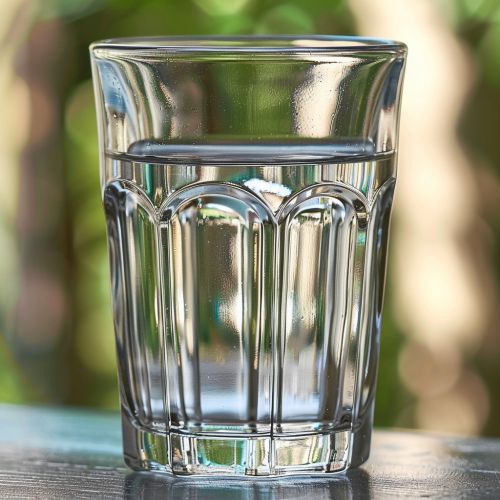Newtonian fluid: Difference between revisions
(Created page with "== Introduction == A '''Newtonian fluid''' is a fluid whose viscosity remains constant regardless of the stress applied to it. This means that the fluid's flow behavior or viscosity is linear and predictable, and it adheres to Newton's law of viscosity. Newtonian fluids are characterized by a linear relationship between shear stress and shear rate, which is a defining feature of their rheological properties. == Properties of Newtonian Fluids == Newton...") |
No edit summary |
||
| Line 74: | Line 74: | ||
== References == | == References == | ||
[[Image:Detail-91477.jpg|thumb|center|Clear glass of water on a table.|class=only_on_mobile]] | |||
[[Image:Detail-91478.jpg|thumb|center|Clear glass of water on a table.|class=only_on_desktop]] | |||
[[Category:Fluid dynamics]] | [[Category:Fluid dynamics]] | ||
[[Category:Physics]] | [[Category:Physics]] | ||
[[Category:Engineering]] | [[Category:Engineering]] | ||
Latest revision as of 02:21, 21 June 2024
Introduction
A Newtonian fluid is a fluid whose viscosity remains constant regardless of the stress applied to it. This means that the fluid's flow behavior or viscosity is linear and predictable, and it adheres to Newton's law of viscosity. Newtonian fluids are characterized by a linear relationship between shear stress and shear rate, which is a defining feature of their rheological properties.
Properties of Newtonian Fluids
Newtonian fluids are defined by their constant viscosity, which is independent of the shear rate. This means that when a force is applied to a Newtonian fluid, it flows at a rate proportional to the force. The relationship between shear stress (τ) and shear rate (γ) in a Newtonian fluid is given by the equation:
\[ \tau = \mu \cdot \gamma \]
where:
- \( \tau \) is the shear stress,
- \( \mu \) is the dynamic viscosity,
- \( \gamma \) is the shear rate.
This linear relationship is what distinguishes Newtonian fluids from non-Newtonian fluids, whose viscosity can change with varying shear rates.
Examples of Newtonian Fluids
Common examples of Newtonian fluids include:
These fluids exhibit a constant viscosity at a given temperature and pressure, making them predictable and easy to model in various applications.
Mathematical Modeling
The behavior of Newtonian fluids can be described using the Navier-Stokes equations, which are fundamental equations in fluid mechanics. These equations describe how the velocity field of a fluid evolves over time and are given by:
\[ \rho \left( \frac{\partial \mathbf{u}}{\partial t} + (\mathbf{u} \cdot \nabla) \mathbf{u} \right) = -\nabla p + \mu \nabla^2 \mathbf{u} + \mathbf{f} \]
where:
- \( \rho \) is the fluid density,
- \( \mathbf{u} \) is the velocity field,
- \( t \) is time,
- \( p \) is the pressure,
- \( \mu \) is the dynamic viscosity,
- \( \mathbf{f} \) is the body force per unit volume.
These equations are used to model the flow of Newtonian fluids in various contexts, from simple pipe flow to complex aerodynamic simulations.
Rheological Behavior
The rheological behavior of Newtonian fluids is characterized by their constant viscosity. This behavior can be observed in a rheometer, an instrument used to measure the flow properties of fluids. In a rheometer, a Newtonian fluid will exhibit a linear relationship between shear stress and shear rate, confirming its Newtonian nature.
Industrial Applications
Newtonian fluids are widely used in various industrial applications due to their predictable behavior. Some of these applications include:
- **Lubrication:** Newtonian fluids like mineral oil are used as lubricants in machinery because their constant viscosity ensures consistent performance.
- **Hydraulics:** Hydraulic fluids are often Newtonian, providing reliable and predictable force transmission in hydraulic systems.
- **Chemical Processing:** Many chemical processes involve Newtonian fluids, where precise control over fluid flow is essential for consistent product quality.
- **Food and Beverage:** Water and other Newtonian fluids are used in the production and processing of food and beverages, where consistent viscosity is crucial for quality control.
Experimental Determination
The viscosity of a Newtonian fluid can be experimentally determined using various methods, such as capillary viscometers, rotational viscometers, and falling ball viscometers. These instruments measure the resistance of the fluid to flow under controlled conditions, allowing for the precise determination of its viscosity.
Temperature and Pressure Dependence
While the viscosity of a Newtonian fluid is constant with respect to shear rate, it can vary with temperature and pressure. For most Newtonian fluids, viscosity decreases with increasing temperature and increases with increasing pressure. This temperature and pressure dependence must be accounted for in practical applications to ensure accurate predictions of fluid behavior.
See Also
References


